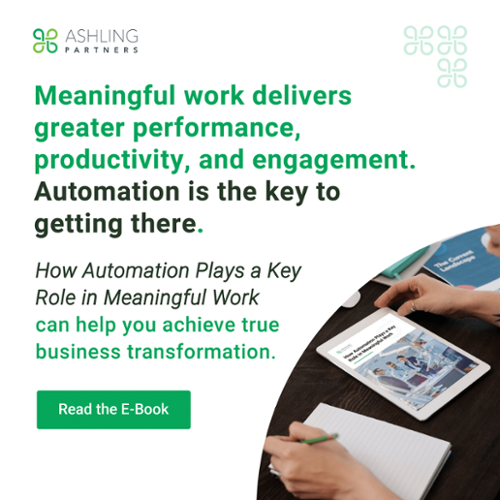Most businesses are eager to be faster and better at their core competencies. They need to innovate and accelerate to achieve business goals, improve efficiency, reduce costs, and create more value for their customers.
To reach these objectives, reliance on technology is often key. While the landscape of technology is broad, one option stands out among the rest: automation. One of the most vital aspects of automation is robotic process automation (RPA), which can deliver substantial returns. You may be wondering which processes can be automated using RPA.
We’ve got the answers in this post. You’ll learn what RPA is, its benefits, and specific use cases that can apply to your business.
What Is RPA?
Robotic process automation describes a system of “digital workers” assuming repetitive, rules-based tasks. It applies to any action that is the same every time and is scalable across an enterprise. These “software robots” can mimic many human activities, including keystrokes, navigation, and data identification and extraction.
Most organizations deploy RPA to remove transactional work from humans so that they can focus on more strategic assignments. It also provides benefits related to reduced costs, fewer errors, faster processes, and more productive and satisfied employees.
As you can see, the advantages are many with RPA. Let’s look at some of these benefits in detail.
What Are the Benefits of RPA?
Implementing RPA can provide a host of benefits for your employees, customers, and business, including:
Improvements in Quality and Accuracy
When bots consistently execute tasks, there’s no deviation. As a result, 90 percent of companies using RPA experienced these improvements.
Boosts in Productivity
RPA’s objective is to speed up labor-intensive processes, and 86 percent of businesses reported productivity gains by using it.
Reduced Costs
Organizations can realize savings in areas of labor, operations, and software costs. In fact, 59 percent of organizations saw improvements here. The savings result from requiring less labor for manual work, accelerating processes so delays don’t add costs, and adding functionality or interoperability between existing technologies.
Revenue Growth
If RPA removes the transactional aspect of workflows, employees can focus more on revenue-generating activities. For example, if RPA helps salespeople automate functions around admin work, they have more time to sell.
Support for Compliance Requirements
RPA can also help any company that must adhere to compliance regulations. It creates a log of all compliance tasks and a clear audit trail. It removes human error from the process, too. Substantiating this point is that 93 percent of organizations agree that RPA improved compliance.
More Satisfied Employees
If you clear out the hurdles of manual, repetitive tasks, your staff will be able to work on things that matter most. That leads to greater fulfillment and engagement as they spend their time on meaningful work. When this occurs, retention improves, as does innovation; 57 percent of executives said RPA improved employees’ customer service.
Accelerated Transformation
Organizations continue to strive toward digital transformation but can hit roadblocks along the way due to legacy systems and inefficient workflows. RPA is a solution to overcome these, and 63 percent of executives cited it as a major component in transformation.
With all these benefits, you can easily see the value of RPA—but which processes can be automated by using RPA, and how do you choose which ones to prioritize?
How to Choose Which Processes to Automate
When looking at automation to solve problems and drive results, what you choose to automate depends on several factors. The key ones are:
- Your goals
- The challenges that keep you from achieving them
- The time to value of automating one process over another
In developing your shortlist, look for the following:
- Processes that require substantial labor and are inconvenient for workers
- How complex the process is, as those that are more complicated take longer to deploy
- Tasks that are highly definable and occur consistently every time
- Anything with a high transactional volume
- Tasks with readable inputs
- Business rule-driven processes
These parameters will be essential when deciding what process to automate. Next, we’ll review some use cases of RPA in action.
Use Cases for RPA: What You Can Automate
Which processes can you automate by using RPA? Experts suggest that 69 percent of routine work could be fully automated by 2024. That’s a substantial number of tasks that software robots can support. We’re not there yet, but there are many ways to adopt it to get results now.
RPA Supports Contact Centers
Wasted time and effort in this ecosystem lead to dissatisfied workers and frustrated customers. RPA can solve many of these issues within contact centers:
- Ticket tagging, which can classify it in many ways, from the product to the urgency
- Providing historical information to agents through system integration, such as surfacing customer relationship management (CRM) notes from previous interactions
- Managing customer refunds by automating the steps to verify the return
RPA and Financial Activities
Financial tasks are often document-heavy but typically follow the same cadence. RPA is an asset for this department. It can support invoice and payment processing, vendor contact management, reconciliation, legacy platform integration, account setup, auditing and compliance, fraud detection, and forecasting.
RPA Accelerates Hiring
Labor challenges are impacting many industries, and they need new ways to recruit and onboard employees. RPA can help with the automation of application processes to identify the best candidates. Those tasks include screening and assessing applicants based on their resumes or information they input into an applicant tracking system (ATS).
Once employees are hired, automation supports faster onboarding that’s less expensive than manual processes. It can digitize the entire process, which helps HR teams manage time better and creates a better user experience for new hires.
RPA and Sales Processes
Salespeople don’t want the burden of administrative tasks. However, it’s critical to keep customer information updated and note interactions as customers move through the buying journey. RPA can assist by automating end-to-end processes in the sales ecosystem, such as eliminating data entry for sales orders and invoicing, removing duplicate data, providing the most current pricing and rate cards, and more.
RPA Solves Data Aggregation Issues
Data is a valuable asset for any business. The problem often lies in the fact that data lives in silos across disparate systems. Aggregating it for enterprise use is imperative, but manual processes are too labor-intensive. It may be too late to act on data in this scenario. RPA comes to the rescue here, as well. It can extract data from systems and combine it into a central repository for analysis and action.
RPA’s Impact on Data Entry into Enterprise Systems
Many companies depend on the data within their enterprise resource planning (ERP) systems. Manually doing this is daunting and can be error-prone. RPA can automate entire workflows from data entry to data gathering to data processing and validation. A process that once took hours now only requires minutes.
Automating Processes with RPA: Start Your Journey
By implementing RPA, you can automate many aspects of your company. There are financial and efficiency-related advantages, but one of the most vital is providing an environment for more meaningful work. Your employees deserve technology tools that enable them to be more productive and connected.
If you’re ready to begin your automation journey, we can help. Our experts will guide you to ensure you get the greatest value from this technology. Schedule a Consultation today to get started.



